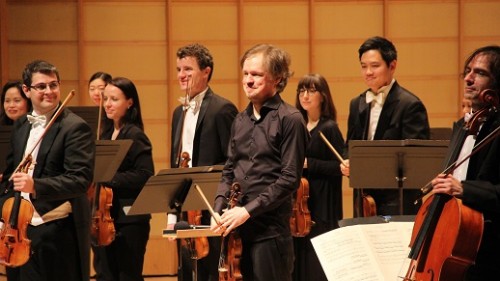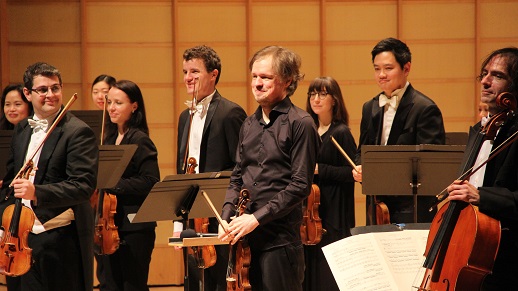 Canada Grieg, Svendsen, Kraggerud, J. S. Bach: Jason Ho (violin), Victor de Almeida (viola), Zoltan Rosznyai (cello), Vancouver Symphony Orchestra / Henning Kraggerud (violin/director), Chan Centre, Vancouver, 22.2.2019. (GN)
Canada Grieg, Svendsen, Kraggerud, J. S. Bach: Jason Ho (violin), Victor de Almeida (viola), Zoltan Rosznyai (cello), Vancouver Symphony Orchestra / Henning Kraggerud (violin/director), Chan Centre, Vancouver, 22.2.2019. (GN)

Grieg – Holberg Suite Op.40
Svendsen – Romance for Violin and Orchestra Op.26
Kraggerud – Postlude No.2 in D minor (from Equinox)
J. S. Bach (arr. Kraggerud and Simen Lund) – Goldberg Variations
Norwegian violinist Henning Kraggerud has enviable resources to utilize in any concert: wonderful talent in playing his instrument, a natural ability to undertake play/direct formats and imagination in introducing his own compositions into the mix. As this concert illustrated vividly, there is another attribute that stands out: Kraggerud’s ability to convey his love of the music – his charming stories and metaphors included – in such a way that even the uninitiated can find an entrance point into the experience. It was rare to attend a concert so accessible and delightful yet with so little pretence or show. Naturally, proceedings started from the violinist’s homeland with Grieg’s Holberg Suite and Johan Svendsen’s lovely Romance. Then it was the violinist’s own compositional efforts: Postlude Two from Equinox and the big piece, his new string orchestra arrangement of Bach’s Goldberg Variations (just released on Simax). Interestingly, the magic of this concert may have started from Kraggerud’s opening story about Grieg’s ‘little green frog’ that he apparently carried in his pocket at all times – a good luck inspiration for composing and everyday life. Somehow the metaphor stuck: there seemed to be lots of delightfully jumping green frogs in the Holberg Suite, and I’m sure I heard them in the Goldberg Variations too.
Grieg’s popular suite started things off with great aplomb and a sense of life, finding keen dramatic accents and rhythmic address and cultivating a nice underlying flow as well. The split VSO (its other members were performing a different concert) did an excellent job in bringing things together, even though not all the principals were present and rehearsal time was somewhat limited. The Sarabande moved forward with considerable depth of feeling, while the sense of dance was strongly etched in the Gavotte. I felt some heaviness only in the Air, where the string playing was less than fully confident. Nonetheless, Kraggerud himself led the orchestra into the Rigaudon with brazen spirit and great fiddling, ending the piece with inspiring character overall.
If ever there was a labour of love, then it was Kraggerud’s playing of Svendsen’s Romance for Violin and Orchestra – one of the violinist’s favorite short pieces and a work actually composed in a single day. It would be difficult to find a more breathtakingly beautiful rendering than this, tonally wondrous, searching and consummately felt. It immediately cast a spell over the audience. For contrast, the first half finished with Postlude Two, drawn from the set of 24 postludes that comprise the violinist’s composition Equinox. This is a rustic, rhythmic piece flowing with high spirits and inspired by the city of Prague – perhaps Kraggerud’s own take on a Slavonic Dance.
The main course was the string orchestra arrangement of Bach’s Goldberg Variations by Kraggerud and Bernt Simen Lund. One might argue endlessly over what instrumental arrangement works best for this piece (harpsichord and piano are the most common), but since the composer arranged virtually everything he wrote for alternative instrumental forces, one has little reason to object to the current experiment. While the arrangement consciously aimed to incorporate authentic features, it is not really a score for purists. What impressed me most are a greater expressive aura and narrative variety, which succeed in giving the work more public accessibility. Nonetheless, there was still a tender spirit running through it all, and a quartet of soloists were employed to bring out the more individualized expression.
Kraggerud did an excellent job of securing a searching posture for his own contributions: for example, the famous Variation 25 was beautifully achieved. I did notice the melodic lines more in this treatment, and the constructional blueprint conspicuously aimed to contrast some of the more inward legato variations with rhythmically demonstrative statements. Some of the latter certainly had a brusqueness and weight that conjured up some Holbergian ‘frogs’, while a few later variations were sufficiently lush and glowing and had me thinking of Sir Thomas Beecham’s Handel. But these adventures all seemed to be part of the playfulness and joy that Kraggerud wished to convey in his arrangement. Perhaps he is telling us that we endow this work with an extreme seriousness and gravity today that Bach wouldn’t have intended. The orchestra and soloists gave a creditable showing, though it must have been difficult for them to learn all this quickly. At times the counterpoint could have been tighter, and the lower/middle strings might have been less diffuse at volumes below mezzo-forte. But it was a novel and refreshing experience, and one that extended the magic of this concert into a somewhat unexpected place.
Geoffrey Newman
Previously published in a slightly different form on http://www.vanclassicalmusic.com.
